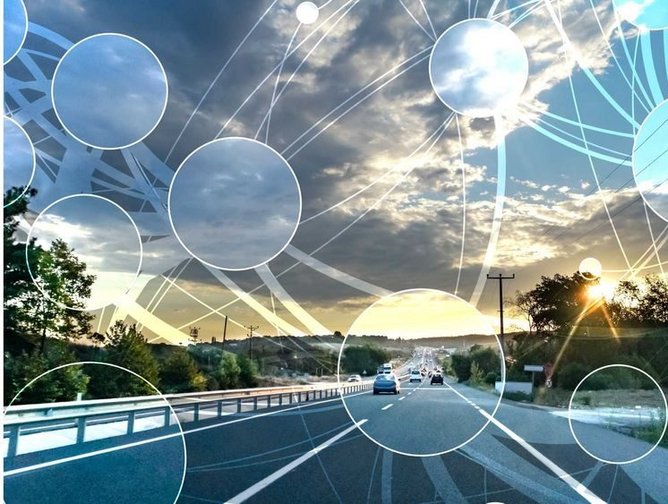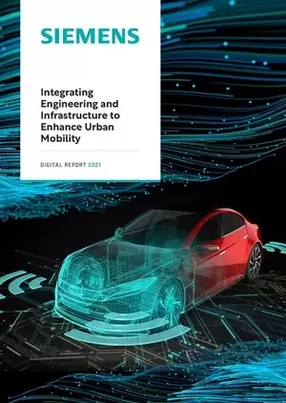How will the hard-fought vision of autonomous mobility finally be realised? Siemens has brought together two of its global businesses to achieve a goal that will pave the way for safer, greener more efficient modes of travel in our cities. Siemens Digital Industries Software is working with OEMs to guide the development of the hardware and software required for safe, highly autonomous vehicles. Allied to this, Siemens Mobility’s efforts to deliver the compute requirements and communication capabilities needed for the smart city infrastructure will allow vehicles to apply the information received and make intelligent decisions.
A challenge met through collaboration
“Ours is a multi-pronged approach,” explains David Fritz, Senior Director, Autonomous and ADAS at Siemens Digital Industries Software (DISW). “At Siemens, we’re engineering-centric and, with automotive, need to help our partners understand how to make the journey from the mechanical to the digital. It's a big leap and the Siemens Xcelerator portfolio of integrated software and services is helping us make that jump, by providing our partners with the ability to transition many disparate parts into a cohesive system. This includes not only engineering level simulation, but also requirements tracking and traceability from concept all the way through to the production of the vehicle itself.”
Siemens Mobility is working to prove the concept of smart cities with governmental bodies and municipalities to deliver the future of mobility, particularly in urban environments. “Technology works best when it’s in the background,” maintains Kunal Chandra, Vice President, Shared Autonomous Mobility at Siemens Mobility. “The purpose that a technology serves should be the driving factor. If you apply autonomous vehicles to public transport you can achieve much higher decongestion of cities. Right now, cities are designed around accommodating vehicles. Frankly, it's bizarre that we have so many journeys of two kilometers where a 75-kilo person is transported in a two-ton car. It’s a problem we’re aiming to solve while making that solution cost-efficient, safe, demand responsive, accessible, and convenient.”
Safety, Security & Reliability
“If you're going to entrust your well-being to a computer, you want to make sure it’s safe to do so,” reasons Fritz. “A big part of the problem is how you can actually show that the vehicle making decisions for you is making them with the appropriate amount of caution. We’re working with governments and regulatory bodies on solutions that make engineering and practical sense.”
Fritz explains his team’s approach is based around scenario level testing for safety. This is combined with security that goes beyond software, starting at the chipset level with integrated circuit design implementation. Reliability is key, because, he reasons, it’s no good having a safe and secure vehicle you can’t rely on to get you from A to B.
“There are many standards emerging to address the key issues at various levels. Therefore, getting involved in their creation and promoting those initiatives is key. However, the big issue remains: How do you show safe, secure, and reliable? Today, everyone is aware of the likes of Tesla and GM, but it's going to take a fleet of hundreds of cars, decades, if not centuries, to drive enough unique miles and encounter enough unique situations to statistically show they're safer than a human driver.”
That approach is, of course, totally impractical and not the one preferred by engineers like Fritz and Chandra. “We’re leveraging the formalism and determinism of digital twins of the vehicle,” explains Fritz. “It can then be shown to behave just like the physical vehicle it models, and it can be driven in a virtual world with all of its practical and complex scenarios validated.”
Digital Twin
Using a digital twin enables Siemens to simulate thousands of scenarios to develop the learning that will ultimately support intelligent and safe decisions. In the virtual world there are no boundaries to the scenarios the vehicle can learn from. “I can guarantee you that no autonomous vehicle is sitting at the base of a bridge in San Francisco waiting for an earthquake so it can drive across that bridge to ensure it behaves properly,” reasons Fritz. “Yet, if you're in San Francisco and want to buy an autonomous vehicle, that's an important consideration.”
Region-specific scenarios like this may not happen very often but, when they do, the implications are potentially serious and need to be validated. Many of these are too unsafe or just too difficult to do in a physical vehicle, which is what makes the use of a digital twin so vital.
“Driving students are taught to watch out for pedestrians crossing the road between cars, we’ve all been through that standard process,” reasons Fritz. “If we take that process and identify 50 things you’ve got to learn, we can begin to set up the scenarios for autonomous vehicles that can deliver timeless learnings applicable in all regional settings. Sure, there are many thousands of potential variants of scenarios, but a new driver does not need to experience them all before getting a learner’s permit. What we are saying is that there should be a reasonable set of unsafe and practical scenarios that must be navigated virtually for an autonomous vehicle to earn its learner’s permit.”
Smart Cities
Outside of the Middle East - Neom in Saudia Arabia and Masdar in the UAE being recent examples - there are very few cities that can be built smart from the ground up. In most cities across the globe it’s a case of brownfield development notes Chandra.
“It’s important to accurately diagnose the current status of the system before you can implement change. You might want to deploy autonomous shuttles across Paris, but without understanding the overall impact it will have on the city, we might end up creating many unpriced externalities. Therefore, it is crucial to create a digital twin of the city before you implement any large-scale changes to be able to properly evaluate the overall system impact of the changes. Paris is already on track with this approach, and countries like Singapore are building on the work already done with analogue twins.
The synergy between the digital twin of the autonomous vehicle and the smart city it will operate within needs to be nurtured. “By interfacing with a digital version of the smart city infrastructure we can show that when these vehicles are produced in reality will behave properly in thousands of important scenarios,” adds Fritz.
The ability to communicate across that environment will be supported by cloud-based data handling that allows vehicles to understand, recover and re-use information. Chandra highlights that fast data requirements will rely on low latency communications, which the advent of 5G will further enhance.
“The next step would be to take a vehicle into a real urban environment for testing,” continues Fritz. “In effect, the vehicle would have earned its learner’s permit in the virtual world before it is tested to ensure the physical vehicle behaves as the digital twin predicted it would. This requires the application of a practical methodology based on engineering principles to deliver a safe vehicle.”
To gain traction, Siemens is working with major metropolitan municipalities to develop this synergy and put together a certification process to provide a pathway for autonomous vehicles to get their learner’s permit. “It’s the same process your smartphone has to go through before it can be placed on a network,” says Fritz. “There are environments used to show correct operation before you could take that device to market and connect up to a carrier’s network. Obviously, vehicles require many more checks and balances, which is where the digital twin can help us demonstrate correct interoperability with the smart city infrastructure that will support safe operation.”
A new vision for mobility
Siemens aims to deploy solutions that give back more space to people in cities so they can actually use it to live. “In the long-term, we need to tackle the peak hour problem,” maintains Chandra. “There are certain hours of the day when the demand placed on the entire city infrastructure is high. Yet, as this demand starts to plateau, much of this peak hour infrastructure is sitting there without being utilized.”
Chandra believes it’s vital to make it extremely easy for people to move from one place to another, without having to find a parking spot, or match their schedule with this peak hour problem. “We have to make things demand-responsive,” he says.
“The vision for this technology is to make our cities less passive. They need to become smart and ready to interact with their citizens, however they choose to travel. With the development of fast, low latency communications, we can actually make our cities talk. And with sensors everywhere to monitor the quality of life, to monitor all aspects of mobility, this information would enhance the driving experience and ultimately lower accident rates. Cities can tell us so much, we just need to embrace the opportunity to listen.”




